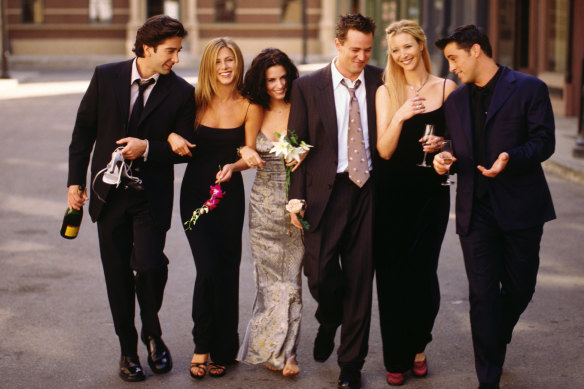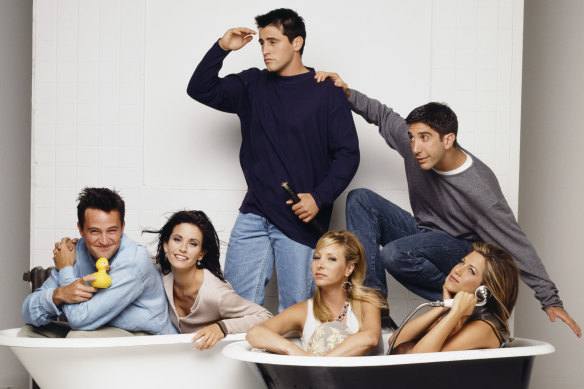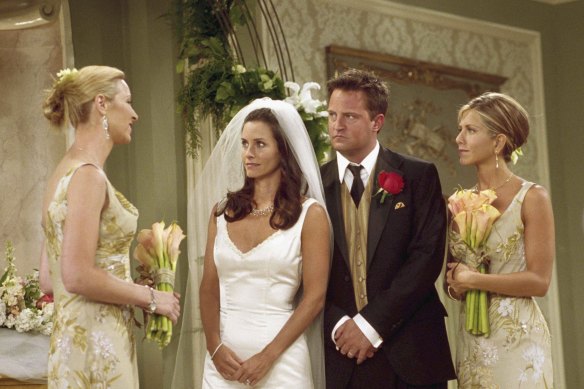This was published 9 months ago
The one where Friends turns 30: Is it still OK to love this comedy fave?
There is plenty about Friends that has not dated well, yet with streaming, the show has found a new generation of fans. What’s the secret to its success?
By Nell Geraets

David Schwimmer as Ross Geller, Jennifer Aniston as Rachel Green, Courteney Cox as Monica Geller, Matthew Perry as Chandler Bing, Lisa Kudrow as Phoebe Buffay, Matt LeBlanc as Joey Tribbiani.Credit: Warner Bros.
Shortly before Friends premiered in September 1994, director James Burrows took the cast of six on a trip to Las Vegas. Unbeknownst to them, it would be their last chance to truly enjoy obscurity.
“I made a reservation for just the seven of us at Spago [a popular Las Vegas spot]. I asked for the centre table in the restaurant, where everyone could see us,” Burrows wrote in his memoir, Directed by James Burrows. “I knew the show had a chance to really take off and told the kids, ‘This is your last shot at anonymity. Once the show airs, you guys will never be able to go anywhere without being hounded.’”
Thirty years have since passed, and Burrows could not have been more correct. After that fateful night in Las Vegas, each of the cast members – Courteney Cox, Jennifer Aniston, Lisa Kudrow, David Schwimmer, Matt LeBlanc and Matthew Perry – would never be able to inconspicuously sit in a restaurant again.
Over the decade it aired, Friends, created by Marta Kauffman and David Crane, became one of the most famous sitcoms ever. Its 236 episodes have collectively attracted more than 100 billion views across all platforms. The finale alone, which aired in May 2004, was watched by 52.5 million Americans.

Still afloat: Some of the jokes have dated, but Friends continues to pick up new fans.Credit: NBCUniversal via Getty Images
What was once a show has become a brand. In London, New York and Melbourne, Friends pop-ups invite fans, both young and old, to immerse themselves in replicas of the sets. There’s a Friends musical parody, an actual Central Perk coffee shop and various Friends-themed card games. So powerful is its legacy that when Perry, who played Chandler Bing, died from the acute effects of ketamine in October last year, the entire world seemed to stop and mourn. Fans flooded social media with tributes, and left flowers and notes outside the Manhattan building used for the series’ exterior shots.
Thanks to its timeless premise – the idea that some friends become so close, they’re family – the sitcom continues to resonate across generations. By the time I began watching Friends in 2010, its ’90s and early-2000s aesthetic already seemed old-school.
But I found comfort in watching six people not much older than myself build unshakeable bonds while muddling their way through early adulthood. For Gen Zs like me, the show offers a glimpse of a simpler time, when people connected IRL rather than online, and social media presence didn’t dictate friendship. We could never revert to that, but it’s a refreshing fantasy, and the reason I’ve since seen the series at least 10 times.
However, loving Friends now usually comes with a caveat. As funny as it is to watch Ross repeatedly scream “pivot” while manoeuvring a couch, or to see Joey’s “smell the fart” acting technique, these jokes are no longer as effective at concealing the show’s flaws.
Take any episode that mentions Chandler’s father, for instance. Friends treated this trans character as a punchline rather than a person, using humour to position their sexuality and gender as “abnormal”. Similarly, the episode in which Ross’ ex-wife Carol gets married to her long-time girlfriend is riddled with jokes about homosexuality: “Tell me if this is too cute – lesbian wedding, chicken breasts,” Monica quips.
Transphobic and homophobic comedy was not unusual for the ’90s and early 2000s, but it makes for uneasy viewing in 2024. In fact, co-creator Kauffman has said the show’s transphobic jokes are the one aspect she’d most like to change.
Then there are the flashback episodes, which depict Monica as a ditsy overweight teen whose love for mayonnaise eclipses all. As writer Kelsey Miller says in Vox, she isn’t just “Monica, fat”, she’s “Fat Monica” – a caricature of fatness, a faceless vessel to fat-shame.
The show’s general lack of racial diversity has also turned heads, especially given the degree to which its creators and cast have defended the casting since the beginning. During season one, Schwimmer, who played Ross Geller, told Rolling Stone the lack of diversity didn’t “necessarily bother him”.
“You can’t do everything to please everybody, and I know that in casting, they did look at all sorts of different people. This just happens to be the group they ended up with.”
Sure, some of the guest stars were racially diverse, such as Lauren Tom (who played one of Ross’ girlfriends, Julie) and Aisha Tyler (who played another one of Ross’ girlfriends, Charlie). Tyler was the most prominent of all racially diverse guest stars, and she only featured in nine episodes. Considering there were 236 episodes, representation was clearly lacking.

The One With Monica and Chandler’s Wedding.Credit: NBCUniversal via Getty Images
On the surface, the combination of homophobia, transphobia, fat-shaming and lack of diversity is more than enough to “socially cancel” a show. Yet Friends remains a cultural juggernaut – fans still request “The Rachel cut” at hairdressers, deck out their hands with rings like Phoebe, and humorously court love interests like Joey (say it with me: “How you doin”?).
So, how has it weathered the storm? As regressive as it often was, it attempted to be equally progressive. Friends sensitively explored various issues, such as infertility, surrogacy, blended families and single parenthood. It struck a tenuous balance between remaining mainstream enough to be palatable for a broad audience at the time, and “radical” enough to satisfy more left-leaning audiences, both then and now.
In his book Still Friends, Saul Austerlitz wrote that “in its embrace of the aggressively normal in its storytelling, it was able to expand the spectrum of normalcy until it could also include a lesbian wedding”. It may have done so clumsily, but at least it tried. Similar could be said of Chandler’s dad and Ross’ interracial relationships. Their representations were deeply flawed, but an imperfect depiction is arguably preferable over total exclusion.
After all, Friends was one of the first US sitcoms to show a same-sex wedding and even went a step further by featuring real-life gay rights activist Candace Gingrich as the celebrant. Yes, nearly every lesbian character at the wedding was made to look hyper-feminine, butif this is what the show’s creators felt they needed to do to keep that top spot in the ratings, they still gave a voice to the voiceless.
For some, these breadcrumbs of progress and representation may simply not be enough for 2024 viewing. But for others, everything that’s good about Friends – the chemistry among the cast, its nostalgic value and its timeless physical gags – outshines the rest.
Loving this show is like loving a childhood friend. You’ve known them for what feels like forever and are acutely aware of their flaws. But do you cast them aside because of them? No, you search for the nuance, the context around their actions, and give them the benefit of the doubt. You love them no matter what.
Find out the next TV, streaming series and movies to add to your must-sees. Get The Watchlist delivered every Thursday.